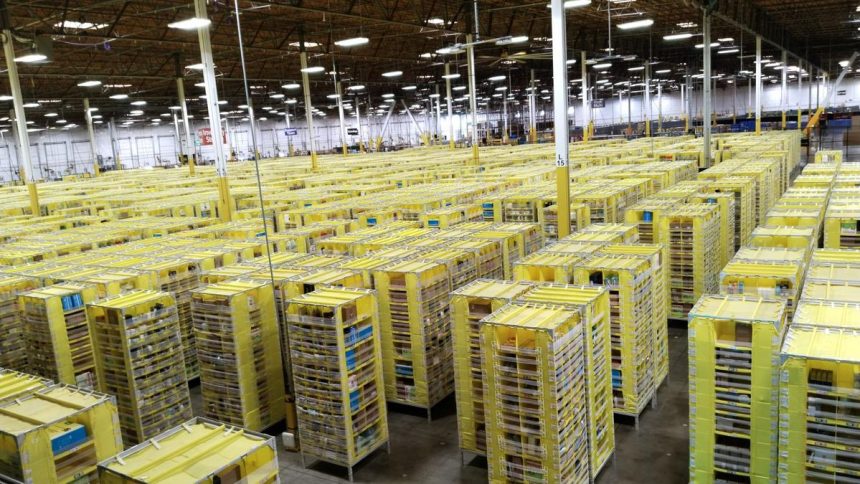Between the time a customer clicks ‘buy’ in an Amazon app and gets the product delivered are a series of tasks that Amazon performs at its warehouse. And a growing number of these tasks are being automated and handled by a system of robots at some of its facilities in the U.S. and few other countries.
At Amazon’s facility in Sumner, Washington, robotic arms pick products from the conveyor belt and send them to another location where they get assigned to a specific spot in totes, a word for open top containers in Amazon parlance. These totes are then stowed away in tall pods waiting to be released when a customer places an order. Separately, another state-of-the-art robotic arm recognises and handles products using artificial intelligence (AI).
Mobile autonomous vehicles, that may potentially replace forklifts in warehouses, move specific racks based on request. Using computer vision, these floor-based robotic vehicles identify the rack where a particular product is placed. Once they identify the rack, they slide under the shelf, slightly lift it up and move to the next point where a warehouse worker will handle the packaging process.
Some of the packaging is also handled by robotic systems. For instance, if the product is under a specified weight, an automated conveyor belt system takes care of packaging and labelling before the item is taken out of the facility.
(For top technology news of the day, subscribe to our tech newsletter Today’s Cache)
ALSO READ Today’s Cache | Amazon axing workforce may not stop with corporate function Replacing humans?
Amazon claims to be the world’s largest manufacturer of industrial robots, and the retail giant has already deployed over 7.5 lakh robots across its facilities globally.
The retail juggernaut is planning to induct Agility Robotics’s state-of-the-art bipedal robot into its army of robots. At the company’s ‘Delivering The Future’ summit, Tye Brady, chief technologist at Amazon Robotics, announced testing of the humanoid robots that can move, grasp and handle totes.
These robots, in some important ways, mimic what humans do at the Amazon facility. It will take time to know how well these robots will perform and how they can adapt to working with other robotic systems.
“It’s early; it’s experimental. We look at it as an opportunity to do something that we might not be able to do with the state of the current technologies that we have,” Scott Dresser, VP of Amazon Robotics told The Hindu.
Amazon is aiming to master mobility and manipulation with the help of robots. By manipulation, Amazon means making robots grasp and handle things. While mobility makes robots move things faster inside the facility, manipulation helps them pick and place items.
Agility Robotics’ bipedal humanoid robots in action | Photo Credit: John Xavier
Since Amazon’s acquisition of Kiva back in 2012, the ecommerce giant has been steadily building a fleet of robots that could do one of the two primary roles independently. With Digit, those two roles are merging. And this intersection is where the retail giant is looking to stay long-term.
“Lot of companies have gone after the bipedal form factor because it is the natural one to look at. It is one, but not the only one form factor where we see the two roles coming together. So, that is why I call it [Digit] an experiment. We need to understand if it is the right way to approach it in our [Amazon] facilities,” Dresser said.
To know how well these humanoid robots fit into a warehouse environment, the company is testing them in the Sumner facility to know about their safety aspects and operational efficiency. During the test phase, these robots are also allowed to interact with workers in the warehouse.
Dresser explained how Amazon deployed autonomous vehicles in some facilities by gathering employee feedback. “When we [initially] put them [the autonomous vehicle systems] out there, people were standing around them, people were jumping in front of them, trying to stop them to make sure they were safe. And when I go there now, people don’t even think about them now,” he said.
The retail giant plans a similar approach to humanoid robot deployment. Based on employee feedback from the current testing, the company may make changes to the robotic system before they are widely rolled out to other facilities.
Ergonomic assist
While the bipedal robots largely mimic what humans do at the facility, Sequoia, another robot Amazon unveiled at its DTF summit, offers ergonomic assistance to workers at the facility so that they don’t have to climb up racks or bend too low to retrieve items from totes.
A warehouse worker engaged in sortation work | Photo Credit: John Xavier
This new robotic system, which may be rolled out in some of its warehouses, is introduced amid increasing scrutiny of Amazon’s health and safety records. In February, the U.S. Department of Labour proposed penalties to the retailer after safety inspectors “found Amazon exposed warehouse workers to a high risk of low back injuries and other musculoskeletal disorders.”
Occupational Safety and Health Administration (OSHA) began investigations into work practices at six warehouses a little over a year ago. Officials found that warehouse workers were prone to injury due to ‘awkwardly twisting, bending and extending themselves to lift item[s].’
“Amazon’s operating methods are creating hazardous work conditions and processes, leading to serious worker injuries,” Assistant Secretary for OSHA Doug Parker said in a statement. “They need to take these injuries seriously and implement a company-wide strategy to protect their employees from these well-known and preventable hazards.”
Amazon has denied claims that it knowingly put its employees at risk and that it attempted to conceal reports of injuries.
Initial deployment
While Amazon continues to develop and deploy robotic systems in some of its warehouses in different parts of the world, the company has not tested robots in any of its facilities in India.
“The mobile robotics and the manipulating robotics are not deployed in India yet,” Dresser said. “But we’re constantly looking at when to put” such systems in place.
The head of Amazon’s robotics division pointed out that while robot-based tech is not deployed in India, the company is experimenting computer vision and other machine learning-related technology in its facilities in the country. He did not share any details about the technology used in the facilities currently.
“We’re excited by the progress we’re seeing with these robots but there are a lot of factors that we consider before deploying these technologies,” Amazon India spokesperson said. “Robots aren’t something you can just flip a switch on – it’s a high bar we’re striving for and in turn, there’s a lot of elements [such as local customer needs, operating methodologies, and industrial standards] we must consider before implementing these technologies in new markets.”
An Amazon employee explains how its latest robotic sortation system, Sequoia, works | Photo Credit: John Xavier
Future outlook
Describing the future of robotics at Amazon, Dresser remarked, “We need form factors that are going to get us into a space where we can get what we’re looking at” and that means the robotic systems will be smaller and effective in moving smaller objects fast.
ALSO READ Amazon’s Zoox tests robotaxi with employees as passengers
Amazon is also working a lot on generative AI. “It’s a logical extension of the sort of narrower ML [machine Learning] work that we’ve been doing in the past. But we’re really building on the foundation models to optimise our systems” to make them “smarter and more intelligent about what they are doing,” he noted.
To make that happen, the robotics division is building frameworks to make different robotic units talk to each other effectively and plan tasks optimally.
“Today, I have algorithms to figure out what are the best ways for them [robots] to travel. But oftentimes, we end up in situations where we have a lot of congestion,” Dresser said, explaining the limitation in the current set up.
“One of the ways we’re looking at using ML and generative AI is to build models around what those traffic patterns look like given various different inputs into the system,” he added.
(The writer was invited to Amazon’s fulfilment facility in Sumner, Washington.)



